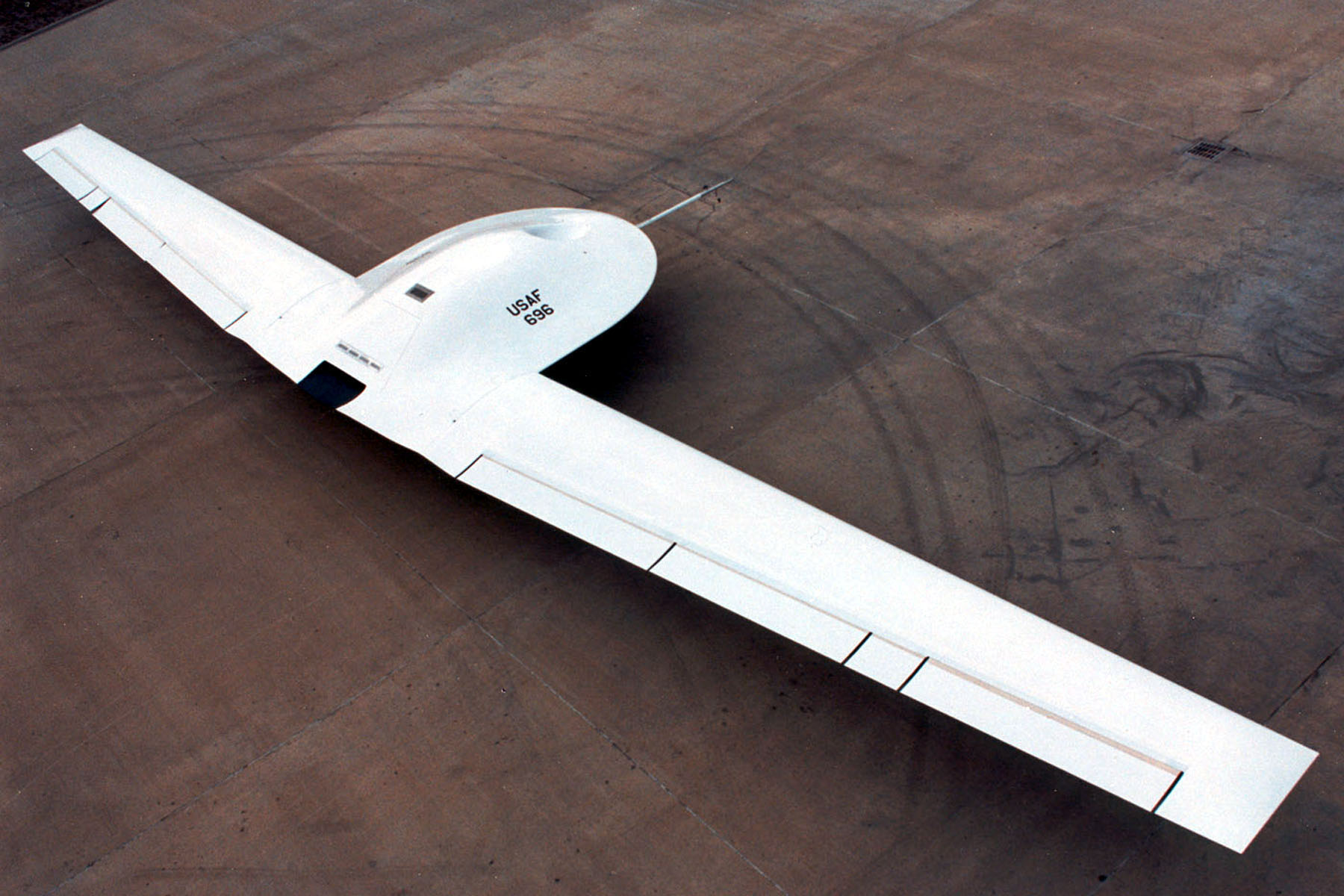Lockheed Martin RQ-3 DarkStar on:
[Wikipedia]
[Google]
[Amazon]
The RQ-3 DarkStar (known as Tier III- or "Tier three minus" during development) is an



DarkStar Tier III- from NASA Dryden Flight Center
{{Lockheed Martin aircraft Q-003 1990s United States military reconnaissance aircraft Unmanned military aircraft of the United States Single-engined jet aircraft Tailless aircraft Unmanned stealth aircraft Cancelled military aircraft projects of the United States Aircraft first flown in 1996 High-altitude and long endurance aircraft
unmanned aerial vehicle
An unmanned aerial vehicle (UAV), commonly known as a drone, is an aircraft without any human pilot, crew, or passengers on board. UAVs are a component of an unmanned aircraft system (UAS), which includes adding a ground-based controll ...
(UAV). Its first flight was on March 29, 1996. The Department of Defense terminated DarkStar in January 1999, after determining the UAV was not aerodynamically stable and was not meeting cost and performance objectives.
Design and development
The RQ-3 DarkStar was designed as a " high-altitude endurance UAV", and incorporated stealth aircraft technology to make it difficult to detect, which allowed it to operate within heavily defended airspace, unlike theNorthrop Grumman RQ-4 Global Hawk
The Northrop Grumman RQ-4 Global Hawk is a high-altitude, remotely-piloted surveillance aircraft of the 1990s–2020s. It was initially designed by Ryan Aeronautical (now part of Northrop Grumman), and known as Tier II+ during development. The ...
, which is unable to operate except under conditions of air supremacy
Aerial supremacy (also air superiority) is the degree to which a side in a conflict holds control of air power over opposing forces. There are levels of control of the air in aerial warfare. Control of the air is the aerial equivalent of comm ...
. The DarkStar was fully autonomous: it could take off, fly to its target, operate its sensors, transmit information, return and land without human intervention. Human operators, however, could change the DarkStar's flight plan and sensor orientation through radio or satellite relay. The RQ-3 carried either an optical sensor or radar, and could send digital information to a satellite while still in flight. It used a single airbreathing jet engine
An airbreathing jet engine (or ''ducted jet engine'') is a jet engine that ejects a propelling (reaction) jet of hot exhaust gases after first taking in atmospheric air, followed by compression, heating and expansion back to atmospheric pressure t ...
of unknown type for propulsion. One source claims it used a Williams-Rolls-Royce FJ44-1A turbofan engine.
The first prototype made its first flight on March 29, 1996, but its second flight, on April 22, 1996, ended in a crash shortly after takeoff. A modified, more stable design (the RQ-3A) first flew on June 29, 1998, and made a total of five flights before the program was canceled just prior to the sixth and final flight planned for the airworthiness test phase. Two additional RQ-3As were built, but never made any flights before program cancellation.
Although the RQ-3 was terminated on January 28, 1999, a July 2003 ''Aviation Week and Space Technology'' article reported that April 2003 that a derivative of the RQ-3 had been used in the 2003 invasion of Iraq
The 2003 invasion of Iraq was a United States-led invasion of the Republic of Iraq and the first stage of the Iraq War. The invasion phase began on 19 March 2003 (air) and 20 March 2003 (ground) and lasted just over one month, including 26 ...
. There has been no independent confirmation.
The "R" is the Department of Defense designation for reconnaissance; "Q" means unmanned aircraft system. The "3" refers to it being the third of a series of purpose-built unmanned reconnaissance aircraft systems.

Survivors
*The second RQ-3A (A/V #2) is at theNational Museum of the United States Air Force
The National Museum of the United States Air Force (formerly the United States Air Force Museum) is the official museum of the United States Air Force located at Wright-Patterson Air Force Base, northeast of Dayton, Ohio. The NMUSAF is the ...
at Wright-Patterson AFB in Dayton, Ohio
Dayton () is the sixth-largest city in the U.S. state of Ohio and the county seat of Montgomery County. A small part of the city extends into Greene County. The 2020 U.S. census estimate put the city population at 137,644, while Greater D ...
. Although part of the Museum's Research & Development Gallery, it is displayed hanging over the C-130E in Building 4's Global Reach Gallery.
*The third RQ-3A (A/V #3) is on display in the Great Gallery of the Museum of Flight
The Museum of Flight is a private non-profit air and space museum in the Seattle metropolitan area. It is located at the southern end of King County International Airport (Boeing Field) in the city of Tukwila, immediately south of Seattle. ...
in Seattle, Washington.
*The fourth RQ-3A (which never flew before the program ended) is held by the Smithsonian National Air and Space Museum in Washington, D.C., but is not on display.
Specifications


See also
Sources
* Specifications and second and third paragraphs: Display information on exhibit atMuseum of Flight
The Museum of Flight is a private non-profit air and space museum in the Seattle metropolitan area. It is located at the southern end of King County International Airport (Boeing Field) in the city of Tukwila, immediately south of Seattle. ...
in Seattle, Washington
Seattle ( ) is a seaport city on the West Coast of the United States. It is the seat of King County, Washington. With a 2020 population of 737,015, it is the largest city in both the state of Washington and the Pacific Northwest region ...
, United States.
References
External links
DarkStar Tier III- from NASA Dryden Flight Center
{{Lockheed Martin aircraft Q-003 1990s United States military reconnaissance aircraft Unmanned military aircraft of the United States Single-engined jet aircraft Tailless aircraft Unmanned stealth aircraft Cancelled military aircraft projects of the United States Aircraft first flown in 1996 High-altitude and long endurance aircraft